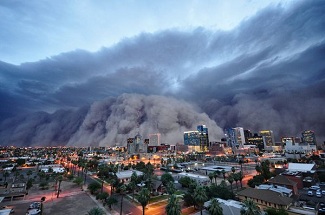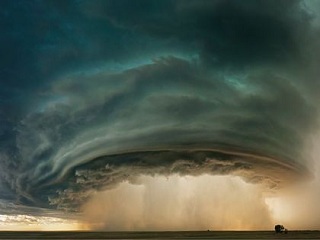What's Causing Extreme Weather?
 Wondering what’s causing all the extreme weather we’ve seen lately? The short answer, scientists say, is rotten luck and a warmer planet.
Wondering what’s causing all the extreme weather we’ve seen lately? The short answer, scientists say, is rotten luck and a warmer planet.It’s not easy to shatter a record that has lasted for more than 75 years. But that’s what happened last month, when a stubborn heat wave pushed July temperatures in the United States into uncharted territory.
Not since 1895, when national record keeping began, has the thermometer stayed so high. The average temperature in July was 3.3°F (1.8°C) above the 20th-century average, according to the U.S. National Oceanic and Atmospheric Administration (NOAA), breaking a record set in 1936.
Besides making life miserable for people in places like Kansas City, Missouri, where the temperature hit 107°F (42°C) on July 25, the withering heat is also taking a toll on wildlife and crops.
Streams in the Midwest got so hot in recent weeks, and water levels dropped so low, that the extreme conditions killed tens of thousands of sturgeon and other fishes. Meanwhile, crops such as corn and soybeans, despite welcome rains across the Midwest this week, have been devastated by the recent drought and are now expected to produce the smallest yields in years, according to the U.S. Department of Agriculture.
Warming Supercharging Extreme Weather
The main forces behind these disasters have been natural weather cycles, such as back-to-back La Niñas in 2010 and 2011 that routed storms away from drought-prone parts of North America, and a massive high pressure system, known as a heat ridge, that parked itself over the U.S. this summer and refused to budge.
But there’s more to the story, said John Nielsen-Gammon, state climatologist in Texas, which just went through the worst one-year drought in its history.
It wasn’t just bad luck that caused these disasters, he explained. Human-induced global warming was also to blame.
Since 1970, the average global temperature has risen by 0.9°F (0.5°C), primarily as a result of greenhouse gases in the atmosphere, according to most scientists. This additional heat has increased the chances for severe heat waves, drought, and other forms of extreme weather.
“Given how little rain we had, we probably would have had record warmth in Texas in 2011 even without climate change,” Nielson-Gammon said. “But climate change added an additional degree or so of heat to it.”

Greater Rainfall Expected
And that’s not all. As Earth’s oceans grow warmer, they evaporate more moisture into the atmosphere—about 4 percent more since 1970, according to recent data. This additional moisture in the air makes it more likely that storms will bring downpours like the ones that hit Beijing in late July.
Authorities there described those rains as the heaviest in six decades. “Everybody knows that if you turn up the fire on your stove, you evaporate the water in a pot more rapidly,” said Jay Gulledge, senior scientist at the Center for Climate and Energy Solutions (C2ES), a think tank in Arlington, Virginia. The more water vapor, the greater the potential for intense rainfalls, he said.
Luck will always play a role in determining whether it’s sunny or rainy on any particular day. But these two factors, rising temperatures and increased moisture in the atmosphere, make the chances for extreme weather that much greater from here on.
For that, we can thank the rise in greenhouse gases, said Gerald Meehl, a senior scientist at the National Center for Atmospheric Research in Boulder, Colorado.
“By adding just a little bit more carbon dioxide to the climate, it makes things a little bit warmer and shifts the odds toward these more extreme events,” he said. “What was once a rare event will become less rare.”
You can return to the main Market News page, or press the Back button on your browser.

